
 USA (1893): Pre-dreadnought Battleship BB-4 1895-1923
USA (1893): Pre-dreadnought Battleship BB-4 1895-1923WW1 US Battleships:
USS Maine | USS Texas | Indiana class | USS Iowa | Kearsage class | Illinois class | Maine class | Virginia class | Connecticut class | Mississippi class | South Carolina class | Delaware class | Florida class | Arkansas class | New York class | Nevada class | Pennsylvania class | New Mexico class | Tennessee class | Colorado class | South Dakota class | Lexington classUSS Iowa marked an improvement over the previous Indiana-class with better seaworthiness due to greater freeboard and more efficient artillery arrangement. Her four 12-inch (305 mm) guns were still in two twin-gun turrets, but the secondary battery of eight 8-inch (203 mm) guns were better placed. She was quickly in the Caribbean by early 1898 as tensions grew with Spain over Cuba. I the Spanish–American War she took part in the bombardment of San Juan (Puerto Rico) and the blockade of Cuba, meeting the Admiral Cervera’s cruiser squadron in Santiago de Cuba when patrolled off the harbor.
The Battle of Santiago de Cuba on 3 July saw USS Iowa hammering four Spanish cruisers with the rest of the fleet. Postwar training exercises saw her with the Pacific Squadron from 1898 to 1902, then South Atlantic Squadron until 1904, and North Atlantic Squadron until 1906. She was modernized between 1908 and 1910 and became a training ship for naval cadets until 1913, decommissioned in 1914, but reactivated by April 1917 as receiving ship, then training vessel, guard ship, decommissioned again in 1919, converted as radio-controlled target ship “Battleship No. 4”, sunk in Fleet Problem I off Panama, March 1923 by the new dreadnought USS Mississippi. #ww1 #spanamwar #1898war #cubanblockade #ussiowa #pre-dreadnought #battleship

An absolutely gobsmaking colorization by Irootoko JR of USS Iowa
Development
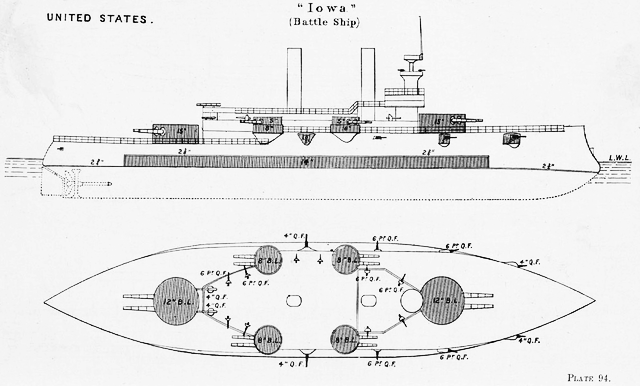
In the early 1880s the coastal defense question raised by the acquisition of battleships by Brazil and a naval arms race in South America made some at the White house and Congress nervous about the prospect of being defenseless in case of a foreign blockade. The United States isolationist policy lad to some neglect of the Navy after the civil war (the old navy) focusing on commerce raiding. After a pair of big gun cruisers (the Atlanta class) and more commerce-raiding cruisers, at last Congress voted construction of two interim armoured ships, USS Texas and Maine.
But the navy soon requested additional funding and a new class of better designed ships in 1887, USS Indiana being authorized at last in 1888, but delayed for design changes until Secretary of the Navy, Benjamin F. Tracy created a Policy Board to solve the matter in January 1890. Tracy wanted a squadron of sea-going battleships to deal with threats overseas, although a faction in the Navy and the Congress still wanted shallow-draft coastal-defense vessels.
Eventually the Policy Board called for eight first-class battleships (for long range projection) and ten slightly smaller second-class battleships (for coastal defence) plus five third-class ships and smaller craft, such as gunboats and torpedo boats in support.
The fleet wanted to concentrate the overseas squadron on the East Coast and so requested the range to reach the Caribbean Sea if needed. This requirement would become even more paramount with the completion of the Panama canal in 1914. In addition to the already voted Maine, Texas, and and New York placed in the third category, new ships were needed for the 1st one. The majority of the Congress, though opposed that conclusion but still approved funding for three “first-class” battleships in April 1890, the Indiana-class. These low-freeboard battleship were a compromise, intended to stay along the east coast from the Maine to the Carribean. They were still intended for coastal defense but proved badly overweight as completed, with a too low belt armor, poor seaworthiness and handling characteristics. The Congress changed politically by late 1890 and it’s only by 19 July 1892, that was founded the “seagoing coastline battleship” the commissioned and now a larger faction in the Navy asked for. It was set to hacv a displacement of 9,000 long tons.
Design of USS Iowa
The Policy Board wanted at first a design which favoured range over protection, and this was submitted to the ream at the Bureau of Construction and Repair which was responsible for the design. They deduced that it was only possible by reducing gun armament compared to the Indianas in order to save space and displacement and increase fuel storage. The 13-inch (330 mm) main battery was removed and replaced also by lighter (standard in Europe) 12-inch (305 mm) guns and replaced some 8-inch (200 mm) secondary guns by lmighter, smaller and faster-firing 4-inch (100 mm). For armour, they were quick to adopt the just patented Harvey armor, far more effective than compound armor. As a result she would have a thinner belt, but procuring the same protection. In addition to increased coal storage, high seas demanded seaworthiness and the designers gave her a greater freeboard and raised forecastle extended amidships. The hull was lengthened to better ride the waves, and displaced more as a result. There were also extra changes in armament (see below).
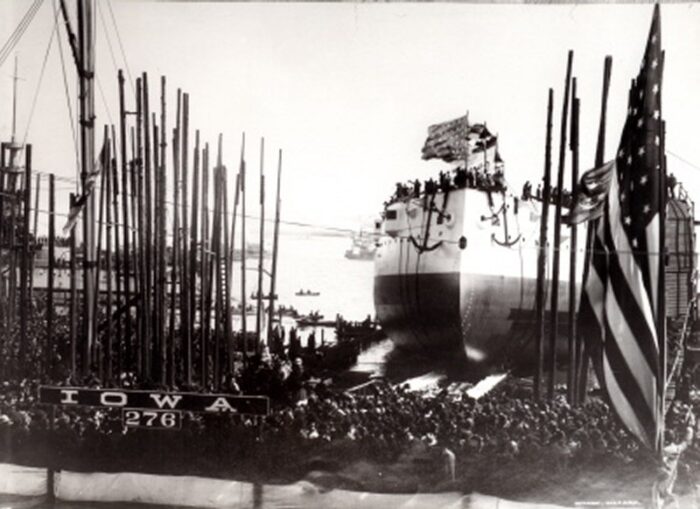
Eventually, USS Iowa was ordered to William Cramp & Sons of Philadelphia, laid down on 5 August 1893, launched on 28 March 1896 and commissioned on 16 June 1897. She was decommissioned three times during her career.
Hull and general design
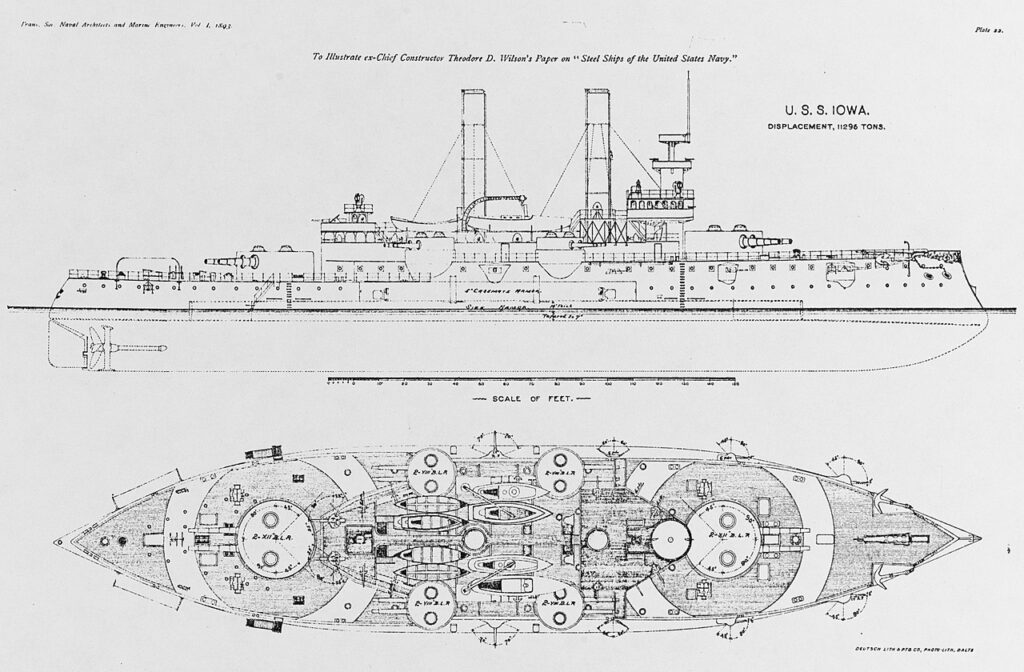
Iowa displaced 11,410 long tons (11,590 t) as designed and up to 12,647 long tons (12,850 t) at full load. She measured 360 feet (110 m) at the waterline, 362 feet 5 inches (110.46 m) overall (so about 10 feet longer than Indiana), for a beam of 72 feet 3 inches (22.02 m) so about 4 feet wider.
She had an average draft of 24 feet (7.3 m), less than Indiana at 27 ft (8.2 m), but in buoyancy she was lighter and wider. Her metacentric height of 4.01 feet (1.22 m) was still better, and she had a righting arm of just 2.23 feet (0.68 m) – lever point when rolling.
Her hull had a French style tumblehome, a first, believed to be the better way to design a more stable hull. It proved wrong latter, so that was a short fad that affected only few ships at the time. She had of course a ram bow, and the upper part of her bulwarked bow displayed simili gold-painted delicate ornamentation around her forward US coat of arms. Thanks to her much greater freeboard she had far better sea-keeping qualities and only a single heavy military mast forward with fighting tops, atop the forward conning tower, and large derrick abreast the aft funnel to manage the service boats. Her crew amounted to 36 officers and 540 ratings.
In general, her hull had not fine but rather large entry lines, with an almost rectangular midship section unlike previous vessels. This was somewhat adverse to speed but enabled to keep the hull short given the barbettes placement and thus, agility.
Protection
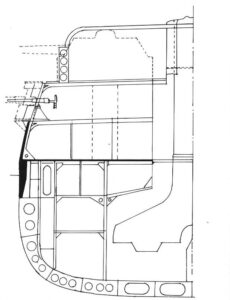 Iowa was the first US ships fitted with Harvey armor. This new process, soon adopted and patented in Europe before the advent of the Krupp process, produced a stronger yet less brittle steel , more compact and lighter than compound armor.
Iowa was the first US ships fitted with Harvey armor. This new process, soon adopted and patented in Europe before the advent of the Krupp process, produced a stronger yet less brittle steel , more compact and lighter than compound armor.
-Main armor belt: 14-in thick over 186 ft (57 m) amidships, 3 ft (0.91 m) above, 4 ft 6 in (1.37 m) below waterline.
-Belt Tapered to 7 in (178 mm), lower edge.
-Citadel bulkheads, angled bulkheads: 12 in thick connected the belt to the barbettes.
-Armored deck: 2.75 in (70 mm) thick level with top edge belt (flat section).
-Deck fore, aft, side down slopes: 3 in (76 mm) on bow and stern.
-Battery upper belt: 5 in (127 mm) thick strake over 4-inch guns
-Upper battery protection: 2 in (51 mm) at 57 mm and 37 mm guns level.
-Main battery turrets: 15 in (381 mm), sides, 2 in crowns, 17 in (432 mm) back.
-Main barbettes: 15 in thick above deck, 12.5 in (318 mm) to the main belt.
-Secondary turrets: 8 in outboard sides, 6 in (152 mm) inboard sides, 2-inch roofs.
-Secondary barbettes: 8 in thick.
-Forward Conning tower: 10 in (254 mm) thick walls.
Powerplant
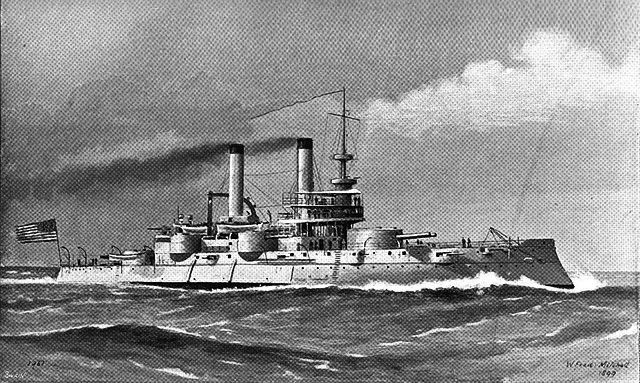
USS Iowa had two 3-cylinder, vertical triple-expansion steam engines driving a screw propeller each. They were fed by five coal-burning fire-tube boilers, three being double-ended, two single-ended and more compact, maximizing internal space. This was two more boilers compared to the Indianas, enabled by the larger internal space gained. The boilers produced steam at max 160 pounds per square inch (1,100 kPa) and were ducted into two, very tall funnels (taller than on Indiana), maximizing draft and avoiding smoke interference with the spotting top. There was forced draft mechanical hoists to remove ash from the boiler rooms. Overall, this machinery was rated by the Yard at 11,000 indicated horsepower (8,200 kW) and procured 16 knots (30 km/h; 18 mph). On trials, she reached 11,834 ihp (8,825 kW) and 17.09 knots (31.65 km/h; 19.67 mph). Coal storage was 1,650 long tons (1,680 t) for 5,140 nautical miles (9,520 km; 5,920 mi) at 10 knots.
She had a single rudder and while at 10 knots she bled speed, making a 180-degree turn in 550 yards (500 m), while at 14 knots (26 km/h; 16 mph) she did the same in 390 yards (360 m), so she was reasonably agile. She was much more stable than the Indiana class with predictable, gentle motion making for a better gun platform.
Armament
Different from the Indianas, it was lighter but overall more modern and better balanced. As usual the light caliber fiesta complicated ordnance management.
Main: 2×2 12-in/35 Mark II
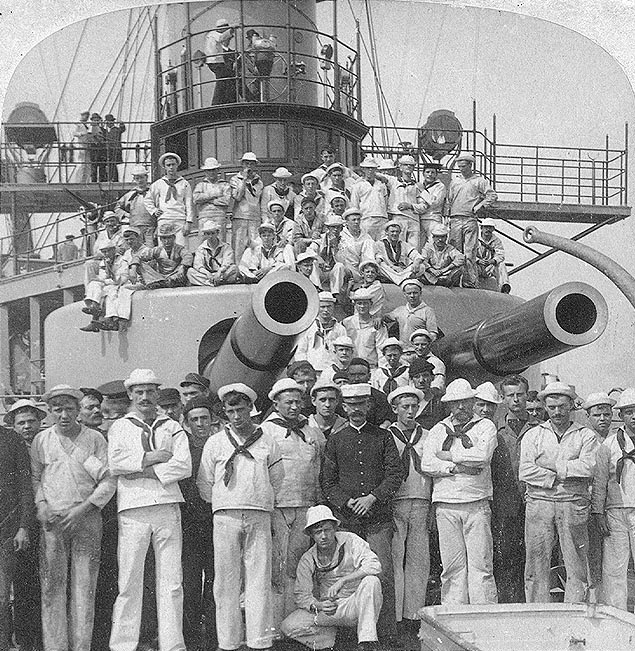
Unlike the previous Indiana class, she had lighter, but faster and longer barreled main guns. Her main battery comprised four 12 in (305 mm)/35 caliber guns in two twin-gun turrets, centerline, fore and aft on deck. These Mark II had elliptically shaped Mark III turrets with flat falls. They were trained hydraulically and hand elevated however up to 14 degrees, depressed to −5 degrees. But they needed to return to 3 degrees for reloading, meeting ammunition hoists bringing up shells and propellant charges, both hydraulically operated. This was standard at the time, but not good for the rate of fire, one shot every three minutes at best with well trained crews, up to five minutes if not.
The guns fired an 850 lb (390 kg) shell at 2,100 ft/s (640 m/s) up to 12,000 yd (10,973 m) at 15° elevation but on land, 21,000 yd (19,202 m) at 30° in special mounts. They fired a 425 lb (193 kg) charge brown powder shell weighting 870 lb (390 kg) armor-piercing. They could penetrate up to 24 in (610 mm) of mild steel at 2,500 yd (2,300 m) down to 19 in (483 mm).
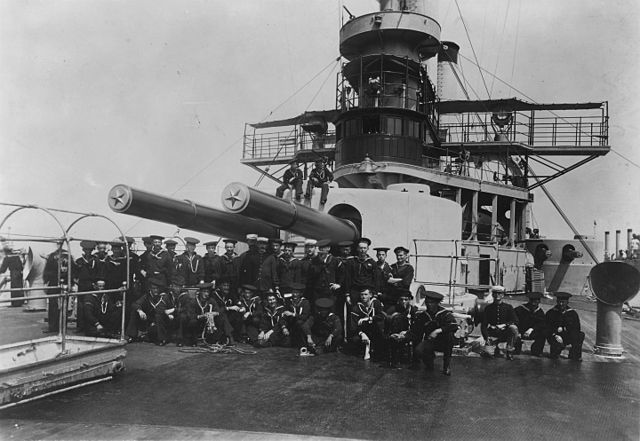
Secondary: 4×2 8-in/35 Mark IV
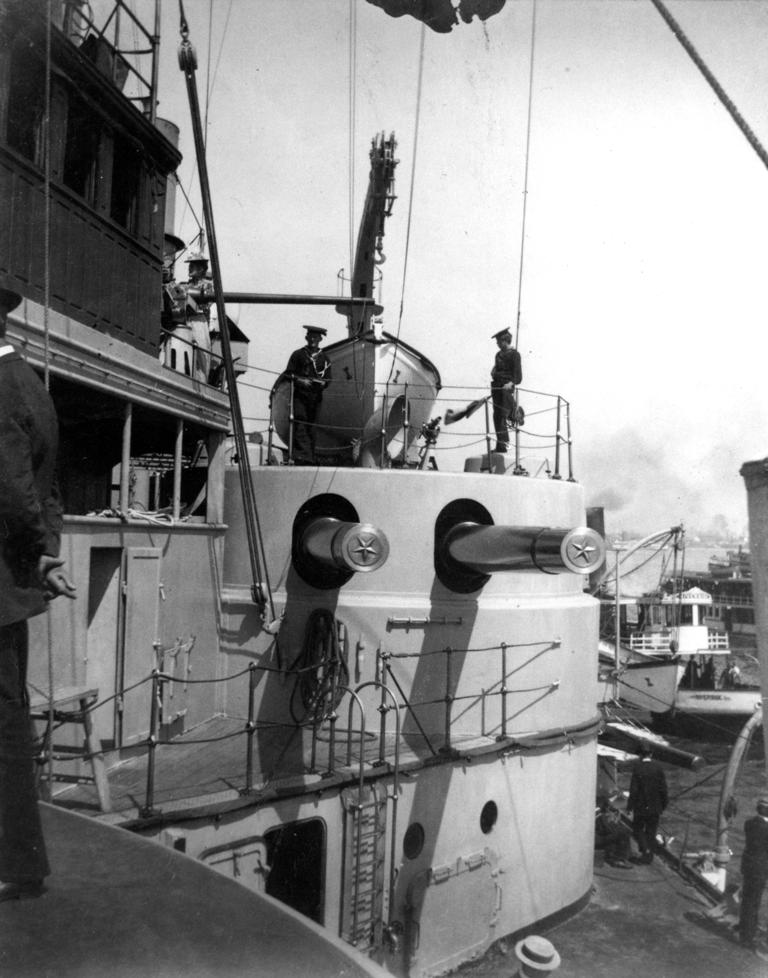
She had eight 8 in (203 mm)/35 cal. 4.5 in (7.73 m) guns in four twin-gun Mark VIII 25 ft turrets wing turrets, which was unusual at the time, most navies preferring hull-mounted barbettes. This was an influence perhaps of the French jeune ecole. In any case, they were less susceptible to water spreay in heavy weather. Two were placed on either side abreast of the funnels on the forecastle esxention and over sponsons. They fired AP rounds to defeat light armor, deal with enemy cruisers, having a rate of fire of one shot per minute to compensate for the slower main guns. Muzzle velocity of 2,100 ft/s (640 m/s), with a 250 lb (110 kg) armor-piercing shell propelled with brown powder charge and then smokeless charges. The rate of fire was then 20 seconds faster. Mounts gave them from −7 to 13 degrees (manual elevation, hydraulic traverse again) with fixed loading at 0 degrees, 16,000 yd (14,630 m) at 20.1° elevation so her probably 12k yards. Compared to the Indianas they had been moved closer together amidships to reduce weight at both ends and improved sea-keeping but also reduce blast interference with the main guns. This was adopted for all subsequent US battleships designs.
Tertiary Guns: 6×1 4-in/40
These six 4 in (100 mm)/40 cal QF guns were intended to deal with approaching lighter vessels, such as spar-torpedo vessels or cripple larger vessel’s superstructures. They combined high rate of fire and high-explosive shells. Four were placed in individual casemates in the forecastle deck, two in sponsons at the bow, two amidships and two guns were in open shielded mounts, aft of the superstructure and superfiring over the aft main turret. They fired a 33 lb (15 kg) HE shell at 2,000 ft/s (610 m/s).
Light Guns and MGs
Now came the anti-torpedo boats battery, evenr faster-firing, with some twenty 57 mm (2.2 in) 6-pounder Hotchkiss guns, plus four 37 mm (1.5 in) 1-pounder guns dispersed around the ship in many individual mounts. This included positions in the fighting top, military mast, and superstructure or sponsoned in the hull.
To round this up there were also normally undercarriage mounted four M1895 Colt–Browning machine guns firing the 6mm Lee Navy. They could be dismounted and used in a landing party if needed.
Torpedo Tubes
The four above-water 14-inch (356 mm) torpedo tubes were located by pairs broadside in the hull, using Howell torpedoed ranged at just 400 yards (370 m) and 25 knots (46 km/h; 29 mph) unique setting with a 400 lb (180 kg) warhead.
⚙ specifications as completed 1897 |
|
| Displacement | Normal 11,410 long tons (11,590 t), FL 12,647 long tons (12,850 t) |
| Dimensions | 362 ft 6 in oa x 72 ft 3 in x 24 ft (110.49 x 22.02 x 7.3 m) |
| Propulsion | 2 shafts TE steam engines, 5× fire-tube boilers 11,000 ihp (8,200 kW) |
| Speed | 16 knots (30 km/h; 18 mph) |
| Range | 5,140 nmi (9,520 km; 5,920 mi) at 10 kn (19 km/h; 12 mph) |
| Armament | 4× 12 in/35, 8× 8 in/35 cal, 6× 4 in/40, 20× 6-pdr, 4× 1-pdr, 4× M1895 MGs, 2x 14-in TTs |
| Protection | Belt 14 in Barbettes 15 in, Turrets 17 in, CT 10 in, deck 3 in |
| Crew | 36 officers, 540 enlisted men |
USS Iowa in action
After fitting out, USS Iowa was commissioned on 16 June 1897 under Captain William T. Sampso for shakedown cruise on 13 July to Newport in Rhode Island until 11 August and Provincetown in Massachusetts then from 14 August to Portland, Maine, until the 23th and then Bar Harbor until September. She sailed to Virginia, Hampton Roads until 16 September, Newport News until the 19th Hampton Roads again and Yorktown until 4 October, Provincetown and Boston, until 22 October. Next she sailed to Tompkinsville in New York and entered the New York Navy Yard for fixes until 5 January 1898. She trained off Virginia, between Hampton Roads and Newport News and then gained Key West, Florida as relations with Spain flared up. She trained between Key West and the Dry Tortugas and after Maine exploded in Havana, she lost her captain, Sampson appointed as President of the Board of Inquiry, replaced by Captain Robley D. Evans on 24 March 1898.
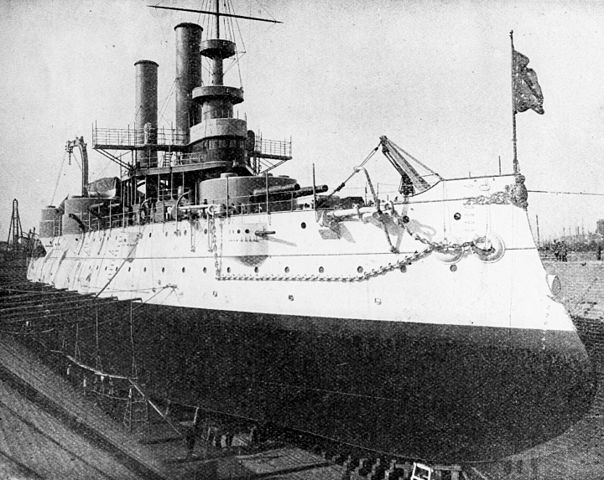
Spanish–American War:
On 22 April blockade of western Cuba started, the Navy moved in, as Congress declared war on Spain and Sampson was now in command of the North Atlantic Squadron with USS Iowa, starting the blockade from 22 April to 1 May. She returned to Key West to refuel, and when back, Sampson learned about the reonforcement of armored cruisers by Rear Admiral Pascual Cervera roaming the Atlantic to attack the blockade squadron so he gathered his spread out ships on 4 May and looked for them, from the faster flagship USS New York, followed by Iowa, Indiana, and Detroit, and soon USS Montgomery plus the the monitors Amphitrite and Terror and the cruiser Brooklyn.
They sailed off Puerto Rico on 12 May, shelled the port, destroying the Castillo San Felipe del Morro fort. Iowa led the line of battle in these passes, but received a Spanish shell wounding three men with splinter damage. Her last main gun salvo caused blast damage to her deck and superstructure. There was one killed on Brooklyn, three wounded in other ships but the fort was silenced. Sampson believed that Cervera was trying to reach Havana which had better fortifications and rushed his fleet there. En route he learned they were coaling in Saint Thomas (Danish West Indies) so instead he veered towards Key West and arrived on 18 May, Cervera meanwhile coming to Santiago de Cuba. Sampson then detached Iowa to join the “Flying Squadron” under Winfield Scott Schley to create a “dynamic blockade” of Cuba, and arrived off Cienfuegos on 22 May.
With USS Texas, Massachusetts, New York, Brooklyn, Marblehead and several gunboats and auxiliary cruisers with supporting vessels she spent a week patrolling off the coast of Cuba and on the morning of 29 May, lookouts on USS Marblehead spotted the incoming Cristóbal Colón in the roadstead so the squadron was scrambled and prepared for action. The attack commenced on 31 May, flagship Massachusetts first, then USS New Orleans and Iowa for a first pass in front of Cervera’s ships, starting firing at 14:05. They fell short but failed later to score any hits, just splinter damage. Spanish return fire was also inaccurate and this stopped at 15:10 when the ships broke off.
Sampson boarded USS New York to take command of the blockade but he knew her had to deal with coastal artillery and mines that blocked the inner harbor so he decided to spend spent the next month in the a stalemate, wait until ground forces can take the port by reverse and deal with the coastal batteries. Iowa was sent to Guantánamo Bay from 18 to 28 June in US hands, and returned to bombard coastal fortifications on 1-2 July with Indiana and Oregon. As troops later approched the hills outside Santiago de Cuba, the Spanish command ordered Cervera to break out. He knew his ships were in poor condition and lacked training but complied and sent a gunboat to clear the minefield in the 2-3 July night.
Battle of Santiago de Cuba:
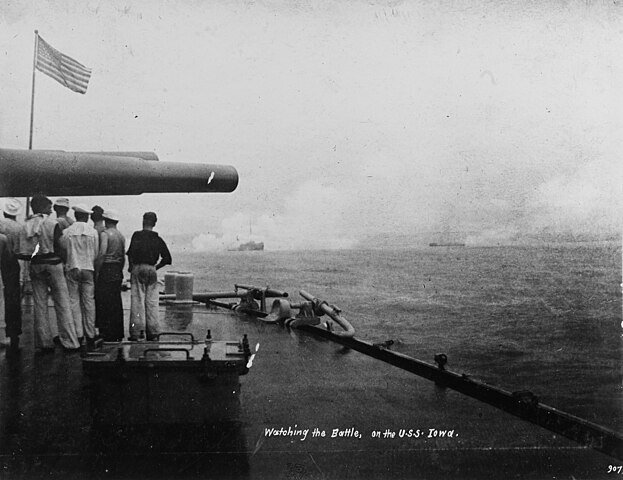
At 08:45 on 3 July, Cervera sortied with his flagshîp Infanta Maria Teresa, followed by Cristóbal Colón, Vizcaya and Almirante Oquendo, the destroyers Plutón and Furor rushing forward and attempting to make a diversion. Iowa was steaming at 5 knots when calling quarters at 09:15 and spot the Spaniard clearing the roadstead at 09:35. But USS New York was too far and Massachusetts was recoaling at Guantánamo Bay. Iowa’s and Brooklyn’s lookouts spotted Cervera and general quarters, the battle quarters were called. Cervera charged at Brooklyn with coastal batteries also firing at long range.
Iowa, Brooklyn, and Texas opened fire at about 09:40 from 6,000 yards (5,500 m) while Iowa’s stoker were hard at work to augment to full speed, and the range fell to 2,500 yards (2,300 m) when Iowa engaged Infanta Maria Theresa with a full all-gun broadside and then turned to port, cross the t of Vizcaya which avoided it. Iowa nevertheless fired on her at 1,800 yards (1,600 m) and then engaged Cristóbal Colón at 1,400 yards (1,300 m) with her entire battery. Cristóbal Colón and Almirante Oquendo engaged Iowa in return with little effect. She took a 6-inch (152 mm) shell, a dud, but making a large hole in her hull. Another exploded with minor damage and fire quickly put out. She had other light hits in her upper works, peppering her bridge and funnels.
But Infanta Maria Theresa was wrecked and soon, fearing a magazine explosion, she was ran aground at 10:25. Almirante Oquendo did the same five minutes later, burning badly. Vizcaya followed ashore but kept her flag high, being finished off by Iowa until she surrendered at 10:36. The two Spanish destroyers were badly mauled, Indiana destroyed Plutón which later exploded, Furor was razed by Iowa, Oregon and Indiana’s light guns and she surrender to the gunboat Gloucester. Cristóbal Colón broke away but later also ran aground.
At 11:00, Iowa launched her cutters to rescue the Spaniards, preyed upon by sharks. Captain Antonio Eulate (Vizcaya) was among the 23 officers and 248 enlisted men recovered. Five more bodies received military honors. Iowa’s boats transferred these to other vessels and on 20 July, as Santiago de Cuba surrendered, she had to returned to port after boiler accident while patrolling. Fireman 2nd Class Robert Penn climbed across to shut off the boiler, being badly burned, later awarded the MoH.
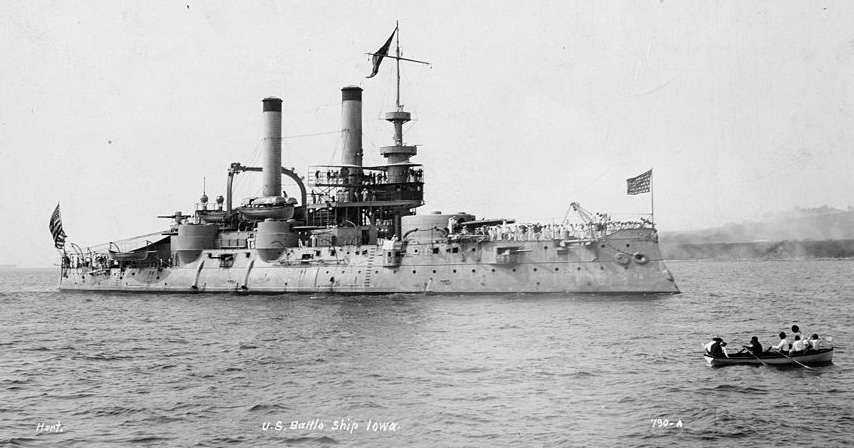
Postwar Service
Iowa was in New York on 20 August for a parade. Captain Silas Terry took command on 24 September and she sailed to the West Coast, joining the Pacific Squadron. She was overhauled at Puget Sound from 11 June 1899. She trained off San Diego, California until 15 January 1900. By March 2012 trained dolphins (Navy’s Marine Mammal Program) managed to recovered her practice torpedo missing its warhead. While in San Diego, she received two 3-inch field guns, four M1895 Colt-Browning for landing parties ashore. She went on her routine of training exercises, firing drills and fleet manoeuvers in eastern Pacific. Captain Philip H. Cooper was in command on 9 June until 1 April 190 but on 8 September she collided with the sailing ship Mary Flint while anchored in San Francisco Bay. The barque sank.
In early February 1902 she ws reassigned to the South Atlantic Squadron as flagship. She sailed to Montevideo, Santos, and Salvador until 8 September, Trade Island and Puerto Belgrano, Rio de Janeiro, and ended back in the West Indies, Gulf of Paria, then took a search exercise off Mayagüez (Puerto Rico) until the end of the year, in joined maneuvers off Culebra and at Saint Lucia and the stopping for Xmas at Port of Spain, Trinidad, back to Culebra on the 30th. By February 1903 she was in St. Kitts, Ponce, and returned on the 11th to New York via Galveston, until 26 February, Pensacola, until 1 April, gunnery practice until 9 April, having one main battery gun exploding. She was repaired at the Pensacola Navy Yard until 23 April and was in New York Navy on 7 May, decommissioned there on 30 June.
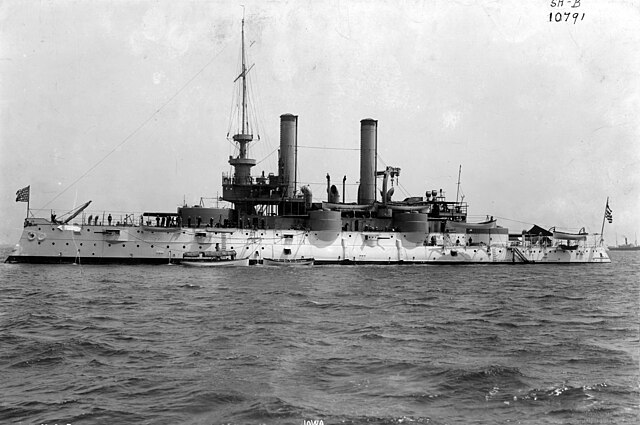
On 23 December she was recommissioned after a refit (4-inch guns aft superstructure replaced by 6-pounder guns in January 1904) and joined the North Atlantic Squadron opearing in European waters. She stopped in Piraeus, Corfu, Trieste, Fiume, Palermo, and Gibraltar (9 to 13 August) then re-crossed the Atlantic via Horta (Azores) until Menemsha, Massachusetts on 29 August, then had practice at target range off Martha’s Vineyard until 19 September. After a stop at Tompkinsville she was back in New York City, Hudson River 5-20 October and having dry dock maintenance at Norfolk Navy Yard from 24 October to 24 December, then Newport News until 30 December.
Later carrer (until 1908)
She ws back in operations by 3 January 1905 at Hampton Roads under Captain Benjamin Franklin Tilley, taking part in maneuvers off Culebra and Guantánamo Bay, Pensacola until 3 May and back to Hampton Roads, Norfolk for fixed until 24 June. She tested there the new floating dry dock “USS Dewey” from 25 to 30 June, followed by periodic maintenance until 3 July. She sailed to New England, Newport, Bar Harbor, Boston, and New York over four months and back to Hampton Roads on 13 October, the Annapolis, Maryland until 7 November and back to North River, New York until 20 November, and Hampton Roads for another refit until 23 December. From 17 January 1906 she sailed for the Caribbean, Culebra, Barbados, Guantánamo Bay followed by Shooting practice until 10 April off Cape Cruz, Cuba. In Annapolis she took part in the ceremonial return of John Paul Jones from Paris, reburied at the US Naval Academy. She stayed off the East Coast and had another overhaul in Norfolk until 30 June 1911.
In July she joined the Second Division, Atlantic Fleet for a tour of New England and a fleet review on 1–2 September by President Theodore Roosevelt. Nothing more to signal, she went on in her training routine and gunnery practice, the Jamestown Exposition and reassignment in the Fourth Division for maneuvers off Virginia. Placed in reserve on 6 July at Norfolk she hosted Lt. Cdr. Clarence Stewart Williams when moved to Philadelphia to be decommissioned on 23 July 1908. She still had the installation of new hydraulic 12-inch gun turrets and new lattice mast aft, then modifie dhoists for her4-inch guns magazines.
Latter years and WWI
USS Iowa was recommissioned at New York Navy Yard on 2 May 1910, under William H. G. Bullard. From 23 May, she joined the Naval Academy Practice Squadron, carried contingents of midshipmen from the Naval Academy and started a training cruise to Europe. She stopped in Plymouth, Great Britain, Marseille, France, and Gibraltar from until July then Funchal, Madeira and Horta in the Azores back home. She had a drydock 6-19 September in New York to install a coaling-at-sea apparatus, testing it with the collier Vestal on 22 September. Back at Philadelphia she ws reduced to reserve.
On 3 May 1911, she was reactivated and carried cadets from the Naval Academy Practice Squadron from 13 May to 5 June but with SS Hamilton rescued passengers from the liner Merida after she collided with the the steamship Admiral Farragut off Cape Charles in dense fog. No human loss. Iowa carried midshipmen to Europe again (Queenstown, Kiel, Bergen, Gibraltar). She was decommissioned in Philadelphia on 1 September, briefly mobilized between 28 October and 2 November (mobilization exercise) moved to New York and Philadelphia.
She was recommissioned in July 1912, newx cruise wit the naval militia members on the east coast. Assigned to the Atlantic Reserve Fleet (Philadelphia) she sailed on 8 October for the fleet review there 10-15 October, in ordinary on 30 April 1913, formally decommissioned for good on 23 May 1914.
From 6 April 1917, she was however placed in limited commission as receiving ship for naval recruits, for six months. She was sent to Hampton Roads, until November 1918 used as training vessel for new recruits and guard ship in Chesapeake Bay.
On 31 March 1919 she was decommissioned for the last time. 30 April she was renamed “Coast Battleship No. 4”, freed for the new South Dakota-class battleship (unbuilt). With the 1922 Washington Naval Treaty she was convert into a radio-controlled target ship in Philadelphia, with a wireless receiver controlling steering and speed, boilers being now oil-fired. She was remotelly sailed to Hampton Roads from 17 August without any crew aboard (a world’s first) from USS Ohio until 10 September. This was a success. More of these target ships will be converted later.
In June 1921, she took part in aircraft bombing tests off the Virginia Capes, measuring how the internal compartmentalization managed bomb attacks. “Coast Battleship No. 4” was tested as moving target on 29 June, attacked with dummy bombs, two hits out of 80. General Billy Mitchell complained simulated bombs had little merit.
Coast Battleship No. 4 was laid up in Philadelphia, as “unclassified miscellaneous auxiliary” IX-6 from 21 July. By April 1922 she served as target off the Virginia Capes by USS Shawmut as control ship, until cancelled. She was transferred to the Pacific Ocean via Panama, targeted by the new battleship Mississippi in Fleet Problem I, February 1923, directed by USS Shawmut. She took 5-inch fire from 8,000 yards (7,300 m) and then 14-inch shells at longer ranges. On 23 March, she was badly mauled by three hits and sank as USS Maryland fired a 21-gun salute for the 1898 war veteran. She was formally stricken on 27 March. Her remains were sold at auction to divers scrappers.
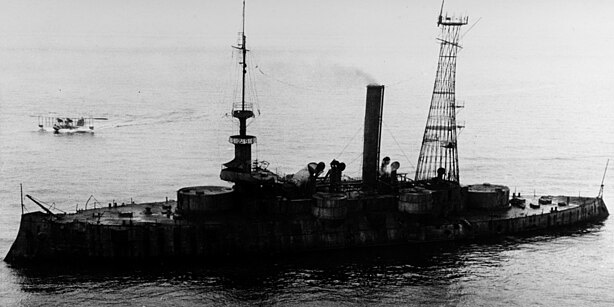
Read More/Src
Books
Campbell, US section. In Chesneau, Roger & Kolesnik, Eugene M. (eds.). Conway’s All the World’s Fighting Ships 1860–1905.
Evans, Mark L. (1 October 2015). “Iowa II (Battleship No. 4)”. Dictionary of American Naval Fighting Ships.
Everett, H. R. (2015). Unmanned Systems of World Wars I and II. Cambridge: MIT Press.
Friedman, Norman (2011). Naval Weapons of World War One. Annapolis: Naval Institute Press.
Friedman, Norman (1985). U.S. Battleships: An Illustrated Design History. Annapolis: Naval Institute Press.
Herder, Brian Lane (2019). US Navy Battleships 1886–98: The Pre-dreadnoughts and Monitors That Fought the Spanish-American War. Osprey Publishing.
Johns, E. B. (1920). “Radio Control of Ships”. Sea Power. IX (4). Washington, D. C.: Navy League of the United States
“Sunk in Sea Crash; 319 Persons Saved” (PDF). The New York Times. 13 May 1911.
“Underwater Archeology Branch Sifts through the Sands of Time with Howell Torpedo”. Department of the Nav 2014.
Links
imgur.com irootoko colorizations-of-ships
navsource.org
history.navy.mil/
en.wikipedia.org 12-inch/35-caliber_gun
en.wikipedia.org 8-inch/35-caliber_gun
history.navy.mil/ through-the-sands-of-time
on timesmachine.nytimes.com
more photos in commons.wikimedia.org/

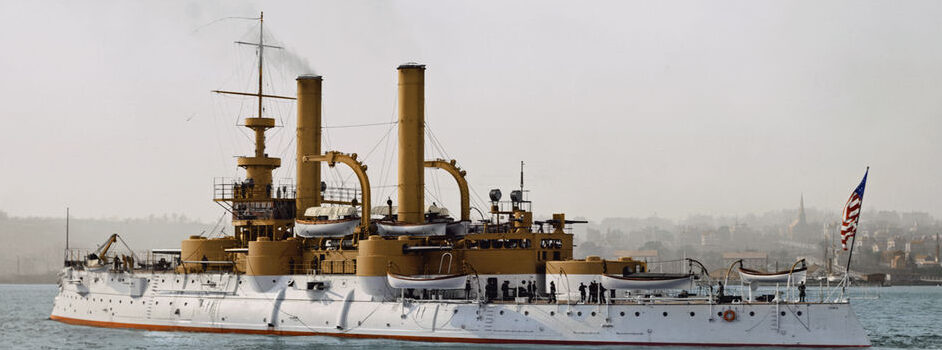
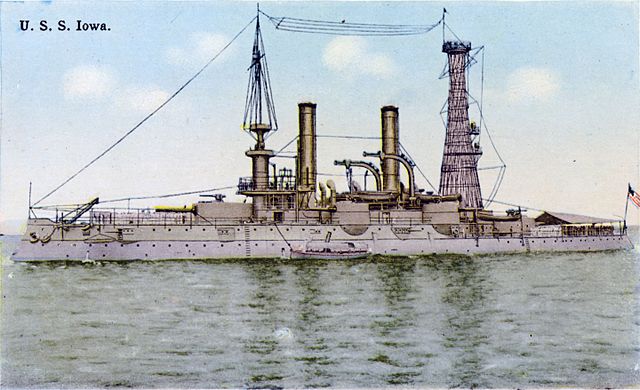
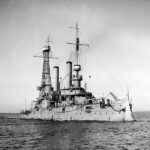
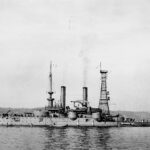
 Latest Facebook Entry -
Latest Facebook Entry -  X(Tweeter) Naval Encyclopedia's deck archive
X(Tweeter) Naval Encyclopedia's deck archive Instagram (@navalencyc)
Instagram (@navalencyc)





 French Navy
French Navy Royal Navy
Royal Navy Russian Navy
Russian Navy Armada Espanola
Armada Espanola Austrian Navy
Austrian Navy K.u.K. Kriegsmarine
K.u.K. Kriegsmarine Dansk Marine
Dansk Marine Nautiko Hellenon
Nautiko Hellenon Koninklije Marine 1870
Koninklije Marine 1870 Marinha do Brasil
Marinha do Brasil Osmanlı Donanması
Osmanlı Donanması Marina Do Peru
Marina Do Peru Marinha do Portugal
Marinha do Portugal Regia Marina 1870
Regia Marina 1870 Nihhon Kaigun 1870
Nihhon Kaigun 1870 Preußische Marine 1870
Preußische Marine 1870 Russkiy Flot 1870
Russkiy Flot 1870 Svenska marinen
Svenska marinen Søværnet
Søværnet Union Navy
Union Navy Confederate Navy
Confederate Navy Armada de Argentina
Armada de Argentina Imperial Chinese Navy
Imperial Chinese Navy Marinha do Portugal
Marinha do Portugal Mexico
Mexico Kaiserliche Marine
Kaiserliche Marine 1898 US Navy
1898 US Navy Sovietskiy Flot
Sovietskiy Flot Royal Canadian Navy
Royal Canadian Navy Royal Australian Navy
Royal Australian Navy RNZN Fleet
RNZN Fleet Chinese Navy 1937
Chinese Navy 1937 Kriegsmarine
Kriegsmarine Chilean Navy
Chilean Navy Danish Navy
Danish Navy Finnish Navy
Finnish Navy Hellenic Navy
Hellenic Navy Polish Navy
Polish Navy Romanian Navy
Romanian Navy Turkish Navy
Turkish Navy Royal Yugoslav Navy
Royal Yugoslav Navy Royal Thai Navy
Royal Thai Navy Minor Navies
Minor Navies Albania
Albania Austria
Austria Belgium
Belgium Columbia
Columbia Costa Rica
Costa Rica Cuba
Cuba Czechoslovakia
Czechoslovakia Dominican Republic
Dominican Republic Haiti
Haiti Hungary
Hungary Honduras
Honduras Estonia
Estonia Iceland
Iceland Eire
Eire Equador
Equador Iran
Iran Iraq
Iraq Latvia
Latvia Liberia
Liberia Lithuania
Lithuania Mandchukuo
Mandchukuo Morocco
Morocco Nicaragua
Nicaragua Persia
Persia San Salvador
San Salvador Sarawak
Sarawak Uruguay
Uruguay Venezuela
Venezuela Zanzibar
Zanzibar Warsaw Pact Navies
Warsaw Pact Navies Bulgaria
Bulgaria Hungary
Hungary

 Bundesmarine
Bundesmarine Dutch Navy
Dutch Navy Hellenic Navy
Hellenic Navy Marina Militare
Marina Militare Yugoslav Navy
Yugoslav Navy Chinese Navy
Chinese Navy Indian Navy
Indian Navy Indonesian Navy
Indonesian Navy JMSDF
JMSDF North Korean Navy
North Korean Navy Pakistani Navy
Pakistani Navy Philippines Navy
Philippines Navy ROKN
ROKN Rep. of Singapore Navy
Rep. of Singapore Navy Taiwanese Navy
Taiwanese Navy IDF Navy
IDF Navy Saudi Navy
Saudi Navy Royal New Zealand Navy
Royal New Zealand Navy Egyptian Navy
Egyptian Navy South African Navy
South African Navy






























 Ukrainian Navy
Ukrainian Navy dbodesign
dbodesign